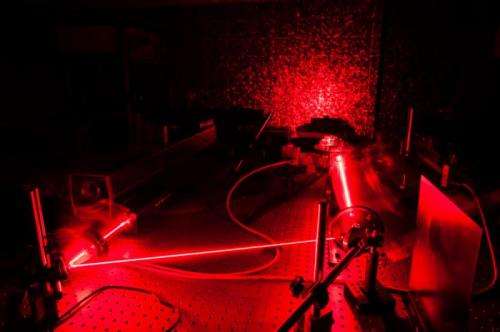Empowering innovation in photonics through collaboration

There is strength in numbers. That is the logic behind an EU-funded project that, by pooling the resources, know-how and technology of multiple organisations across Europe, has helped greatly to advance current research trends in the increasingly important field of photonics.
Photonics, a branch of physics that covers technical applications of light from telecommunications to integrated circuits and sensors, is maturing rapidly. Professor Hercules Avramopoulos, the head of the Photonics Communications Research Laboratory at the National Technical University of Athens, describes the field as being roughly where electronics was in the 1960s.
''In the 1960s you had the first integrated circuits. Photonics today is at the point of a similar breakthrough that will lead to a wealth of applications with widespread benefits for industry and society,'' Prof. Avramopoulos says.
The trend is being driven in large measure by the growing demand for bandwidth and capacity on communications networks - from cell phone services to the internet. In addition, the potential for optical systems to operate at much higher speeds than traditional electronic circuits is driving a need for faster interconnection between datacom systems - from server racks to your personal computer.
Although research in the field is progressing in Europe, Asia and the United States, the sector continues to face several challenges. Not least, in the case of Europe, from the disparate and diverse nature of the research institutes, university departments and companies involved in photonics research and development - among them a large number of small and medium-sized enterprises (SMEs).
''Photonics is maturing rapidly but it is still not at the stage where you can go down to your local shop and buy photonic products as you can buy equivalent electronic goods. Much of the field is still in the phase of researching and experimentation - and doing an experiment in photonics often involves using very expensive equipment and devices that are not broadly available. In addition, you need expertise, often multidisciplinary in order to combine knowledge in the physics of materials with expertise in the field of application. In general you cannot find all these ingredients in individual laboratories,'' Prof. Avramopoulos explains.
In order to overcome these problems, academic and research institutes from 12 European countries came together in the ''Pan-European photonics task force: integrating Europe''s expertise on photonic subsystems'' (EURO-FOS) project with the support of more than EUR 4 million in funding from the European Commission. The consortium put in place the networks and tools necessary to pool resources and technology among a multitude of organisations working on photonics research across Europe, while at the same time helping photonics researchers to share knowledge and expertise. Over the course of four years they carried out close to 100 joint experiments, involving in-excess of 300 young researchers at the doctorate and post-doctorate level.
''The EURO-FOS Network of Excellence (NoE) was driven by the need to enhance and assist collaboration between organisations and researchers across Europe. The project achieved that with great success,'' Prof. Avramopoulos, who coordinated EURO-FOS, explains.
A pan-European photonics laboratory
The 17 organisations that made up the EURO-FOS NoE have extensive expertise in the design, development and testing of photonic components and subsystems that are applicable in high-capacity light-wave communications networks. By clustering together they were able to share their know-how and innovations amongst each other and with other organisations working in the field in an ambitious initiative that has led to the creation of a powerful pan-European virtual laboratory.
Called ''Eurofoslab'', the laboratory pooled state-of-the-art components, devices, subsystems, testbeds and access to deployed optical fibre links. Its resources are physically located at the 17 laboratories of the network, but are centrally administrated by means of web tools developed by the University of Essex in the United Kingdom. The tools enable the reservation of shared resources and scheduling of joint experiments using equipment across Europe.
The inventory of Eurofoslab contains more than 700 items, including 48 complete systems and testbeds, such as terabit-per-second ''Optical time-division multiplexing'' (OTDM) and ''Orthogonal frequency-division multiplexing'' (OFDM) testbeds, coherent ''Wave Division Multiplexing´(WDM) testbeds, WDM transmission systems at 1550 and 1310 nanometres, ''Radio over Fibre'' (RoF) systems based on single-mode and multimode fibres, and many others. It also includes more than 50 self-standing subsystems such as complete ''optical line terminals'' (OLTs), ''optical network units'' (ONUs), transmitters, receivers and regeneration units, as well as a large number of photonic and optoelectronic devices, 14 simulation platforms and access to four installed fibre links.
''The sorts of experiments that Eurofoslab has enabled would not be possible for individual laboratories. Working together with more resources at hand, researchers have been able to embark on more ambitious, large-scale experimental endeavours,'' the EURO-FOS coordinator says. ''In addition it has helped create economies of scale in the development, testing and validation of photonic subsystems and systems.''
Work conducted via Eurofoslab within the scope of the EURO-FOS project has focused on four key areas of photonics research: digital optical transmission systems; optical sources and amplification; high-speed optical network subsystems; and next-generation optical access subsystems.
The work so far has resulted in more than 200 scientific publications and the filing of seven patents. In addition, the network has opened up collaboration opportunities with other organisations around the world and has strengthened ties between the academic community and industry.
''Everybody knows what a cell phone is, for example, but they don''t always know about the underlying technology that makes it work and how innovation could make it work better. As photonics technology matures it will go from experimental research applications to find its way into an increasing number of applications in the real world with potentially enormous benefits for everyone. EURO-FOS has made a considerable contribution toward that goal,'' Prof. Avramopoulos says.



















